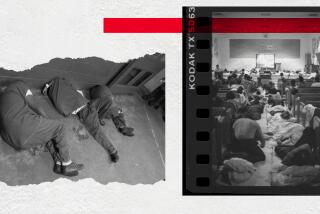Indefinite solitary confinement persists in California prisons
- Share via
Reporting from Sacramento — U.S. prisons typically reserve solitary confinement for inmates who commit serious offenses behind bars. In California, however, suspected gang members — even those with clean prison records — can be held in isolation indefinitely with no legal recourse.
Indeed, hundreds have been kept for more than a decade in 8-by-10-foot cells, with virtually no human contact for nearly 23 hours per day. Dozens have spent more than two decades in solitary, according to state figures.
It’s a harsh fate even by prison standards: Under current policy, an inmate who kills a guard faces a maximum of five years of isolation.
Long abandoned by many states, the practice of indefinite solitary confinement persists in California as a last resort for prison officials struggling to thwart gang activity and extract information from the most hardened gang members.
The policy attracted international attention earlier this summer, when thousands of protesting California inmates joined a three-week hunger strike by prisoners at the state’s maximum-security lockup at Pelican Bay.
Administrators say the violent gang culture is so entrenched in state prisons that isolation is the only way to keep leaders from ordering killings, rapes and assaults on staff and other inmates.
But critics say the unending confinement amounts to torture.
Isolated inmates frequently descend into “hopelessness, desperation and thoughts of suicide,” said Craig Haney, a psychology professor at UC Santa Cruz, who has studied men held alone in the Security Housing Unit at Pelican Bay. Many become paranoid, while others lose the ability to interact in social situations without severe anxiety.
“It’s worse than prisoners in any civilized nation anywhere else in the world are treated,” Haney told lawmakers during an emotional four-hour hearing in Sacramento, where hundreds of inmate advocates and family members packed the gallery to protest the isolation policy.
Other large prison systems prohibit indefinite solitary confinement, in large part because of the psychological toll it can take, rendering inmates even less fit to rejoin society upon their release.
Officials at the U.S. Bureau of Prisons and in many states, including New York, Florida and Pennsylvania, say they use isolation only to punish serious crimes committed behind prison walls — and then for a limited duration. The typical term lasts weeks or months, not years.
“There aren’t special rules for those suspected of being gang members,” said Jo Ellyn Rackleff, a spokeswoman for the Florida Department of Corrections. “Everybody in prison is dangerous.”
Texas, however, also sends unrepentant gang leaders to “the hole” indefinitely. “We’ve seen in the past what happens if we leave these guys in general population,” said state Department of Criminal Justice spokesman Jason Clark, “and there is a significant difference” in the level of violence.
According to California officials, gangs are so prevalent in state prisons that it’s all but impossible for inmates to complete their sentences without becoming involved in the violence. “An inmate who wants to rehabilitate himself cannot,” prisons undersecretary Scott Kernan testified during the legislative hearing last month. “Not when he has an inmate, like the people we have in [isolation], telling him to go stab somebody or he will be killed.”
Though prison authorities make no apologies for their policy, they bristle when observers use “solitary confinement” to describe life in Security Housing Units. “Is it really solitary confinement if you can take correspondence courses and watch something like 27 channels on your own TV?” prisons spokeswoman Terry Thornton asked a reporter. “If I went to prison, I wouldn’t want to share a cell with anybody.”
All but 26 of the 1,056 prisoners isolated in Pelican Bay as of July 1 were being held for their suspected gang affiliations, not for other specific actions or rule violations. Nearly 300 had been there for more than a decade, 78 for more than 20 years.
Inmates can be placed in solitary if investigators find three pieces of information linking them to a gang. Some admit their allegiance, but the wrong tattoo, a letter from a known gang member or the whisper of a confidential informant all count as evidence.
Once in solitary, inmates are presented with a choice: If they name gang members and provide detailed accounts of their alleged activities — assaults, killings, drug smuggling — they are promised a place in a yard reserved for inmates who need protective custody. But there is no way for prison officials to protect them when they are released, advocates say, or to guarantee the safety of the inmates’ families on the outside.
Should the inmates choose not to talk, they stay in isolation for a minimum of six years. If they fail to maintain a spotless disciplinary record, the isolation can be extended indefinitely.
“If you’re given an indeterminate sentence and you’re not going to get out of segregation until you die or inform on someone … that breeds despair and despair leads to suicide,” said Terry Kupers, a psychiatrist and expert on mental health in prisons.
The suicide rate for isolated inmates is substantially higher than for prisoners in the general population, Kupers told lawmakers at the Sacramento hearing.
The state’s policy has been challenged many times, Thornton said, and it has fared well under judicial scrutiny. The notable exception: A federal court found it was unconstitutionally cruel to keep mentally ill inmates locked up in Pelican Bay’s Security Housing Unit for extended periods.
But Charles Carbone, a San Francisco prisoner-rights attorney, said he knew of no case that had directly tested whether the six-year minimum is “arbitrary on its face.”
The hunger-striking inmates at Pelican Bay agreed to start eating after three weeks — the point at which serious health problems typically begin — in exchange for warm hats, wall calendars and a promise from prison officials to reconsider the isolation regulations.
Administrators have been slow to act on such promises in the past. A list of reforms agreed to in 2007, for example, has yet to be instituted. “We have to be careful about how we make these changes,” Kernan told lawmakers. “People’s lives are at stake.”
Meredith Drennan said her son, Matthew Hall, lost 30 pounds during the July hunger strike. Drennan said she has not been allowed to visit him or speak to him on the phone during his five years of solitary at Pelican Bay. They communicate through the mail.
“They tell him the only way to get out is to debrief,” Drennan said, using the prison term for informing, “but then your head will be handed to you. He’ll never do that.”
Hall, 43, first went to prison in 1999 for assault with a deadly weapon, prison records show. He was sent back in 2007 after a parole officer searching his apartment found a gun hidden under his roommate’s mattress, Drennan said.
Hall has violated multiple prison rules, according to Thornton, including participating in a riot. But he was placed in isolation because he is believed to be a member of the white supremacist group the Aryan Brotherhood.
Prison officials said they were reviewing the isolation policy and might recommend some changes by the end of the year. But under current rules, inmates can remain in solitary until their release dates — in Hall’s case, about five years from now.
And that, said Peter Schey, president of the Los Angeles-based Center for Human Rights and Constitutional law, is dangerous. “We’re taking prisoners who were marginally neurotic and evolving them into people who are truly psychotic. And then we let them out.”
More to Read
Sign up for Essential California
The most important California stories and recommendations in your inbox every morning.
You may occasionally receive promotional content from the Los Angeles Times.











